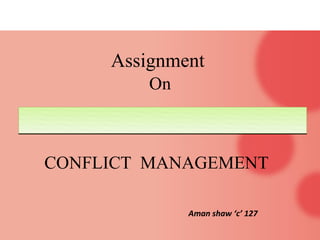
Document (5).pdf
- 1. Assignment On CONFLICT MANAGEMENT Aman shaw ‘c’ 127
- 2. Contents Introduction Views of conflict Characteristics of conflict Source of conflict Functional & dysfunctional conflict Levels & types of conflict Ways to manage conflict Tips for managing conflict Conclusion References
- 3. Introduction: Students bring different ideas, goals, values, beliefs and needs to their teams and these differences are a primary strength of teams. These same differences inevitably lead to conflict, even if the level of conflict is low. Since conflict is inevitable, one of the ways in which faculty members can help students improve their abilities to function on multidisciplinary teams is to work with them to develop their understanding of conflict and their capabilities to manage and resolve conflict.
- 4. CONFLICT an expressed struggle between at least two interdependent parties who perceive incompatible goals, scarce resources, and interference from the other party in achieving their goals Or a process that begins when one party perceives that another party has negatively affected or about to affect something that the first party cares about
- 5. Characteristics of conflict Interpersonal conflict requires at least two people. (Conflict within one’s self, or interpersonal conflict, generally is studied by psychologists. Communication students and scholars are interested in communication between people. ) Conflict inherently involves some sense of struggle or incompatibility or perceived difference among values, goals, or desires. Action, whether overt or covert, is key to interpersonal conflict. Until action or expression occurs, conflict is latent, lurking below the surface.
- 6. Power or attempts to influence inevitably occur within conflicts. If the parties really don’t care about the outcome, the discussion probably doesn’t rise to the level where we call it a conflict. When people argue without caring about what happens next or without a sense of involvement and struggle, it probably is just a disagreement VIEWS OF CONFLICT Traditional view: The belief that all conflicts are harmful and must be avoided Human relations view:
- 7. That belief that conflict is a natural and inevitable outcome in any group Integrationist view: The belief that conflict is not only a positive force in group but that it is absolutely necessary for a group to perform effectively
- 8. Sources of Conflict Conflicts may originate from a number of different sources, including: oDifferences in information, beliefs, values, interests, or desires. oA scarcity of some resource. oRivalries in which one person or group competes with another.
- 9. Functional conflict : works toward the goals of an organization or group Dysfunctional conflict: blocks an organization or group from reaching its goals
- 10. Functional conflict Constructive Increase information & ideas Encourages innovative thinking Unshackles different points of view Reduce stagnation
- 11. Dysfunctional conflict Tension, anxiety, stress Drives out low conflict tolerant people Reduce trust Poor decision because of withheld or distorted Reduce information
- 12. Level of conflict Types of conflict Organization Group Individual Within & between organization Within & between group Within & between individual
- 13. Group Conflict Intragroup conflict: • conflict among members of a group • early stages of group development • ways of doing tasks or reaching group’s goals Intergroup conflict: • between two or more groups
- 14. Individual Conflict Interpersonal conflict: • between two or more people a differences in views about what should be done • differences in orientation to work and time in different parts of an organization Intrapersonal conflict: • occurs within an individual
- 15. • threat to a person’s values • feeding of unfair treatment • multiple and contradictory sources of socialization
- 16. Conflict Management is defined as “the opportunity to improve situations and strengthen relationships”
- 17. 5 ways to manage conflict •Avoidance •Competition (A) •Accommodation (B) •Compromise (C) •Collaboration (D)
- 18. Conflict Continuum I win, you lose (competition—A) I lose or give in (accommodate—B) We both get something (compromise—C) We both “win”(collaborate—D)
- 19. Competition Plus •The winner is clear •Winners usually experience gains Minus •Establishes the battleground for the next conflict •May cause worthy competitors to withdraw or leave the organization
- 20. Accommodation Plus •Curtails conflict situation •Enhances ego of the other Minus •Sometimes establishes a precedence •Does not fully engage participants
- 21. Compromise Plus •Shows good will •Establishes friendship Minus •No one gets what they want •May feel like a dead end
- 22. Collaboration Plus •Everyone “wins” •Creates good feelings Minus •Hard to achieve since no one knows how •Often confusing since players can “win” something they didn’t know they wanted
- 23. Tips for Managing Conflict 1. Avoids feelings or perceptions that imply the other person is wrong or needs to change. 2. Communicates a desire to work together to explore a problem or seek a solution. 3. Exhibits behavior that is spontaneous and destruction-free. 4. Identifies with another team member’s problems, shares feelings, and accepts the team member’s reaction. 5. Treats other team members with respect and trust. 6. Investigates issues rather than taking sides on them.
- 24. Conclusion Individuals should understand their own personal triggers to better deal with conflict situations in the workplace. Group members should think about other group members early on to identify privately those individuals and behaviors that may push their buttons. References: Lakra, Kerobin and Meena, Dinesh chand (2009 and 2010; respectively) Assignment on conflict management, submitted to Department of Extension Education, I. Ag. Sci., B.H.U.,Varanasi
- 25. Rahim, M.A. (2002) Toward a theory of managing organizational conflict. The International journal of conflict management,13,206-235. http://foundationcoalition.org/publications/brochures/conflict.pdf http://www.referenceforbusiness.com/management/Comp- De/ConflictManagement-and-Negotiation.html http://www.scribd.com/doc/25304585/Functional-and-Dysfunctional-Conflicts http://www.mindtools.com/pages/article/newLDR_81.htm